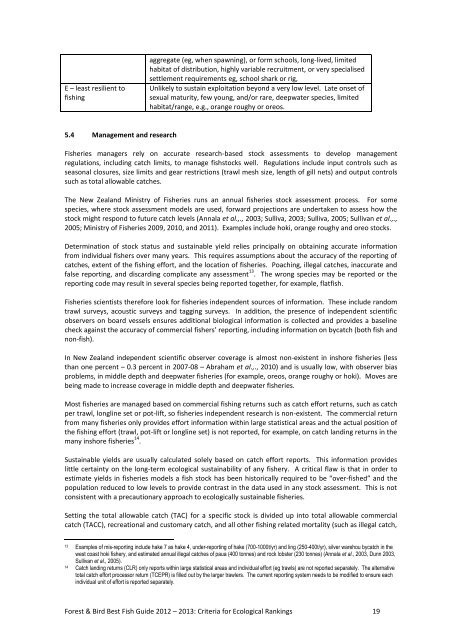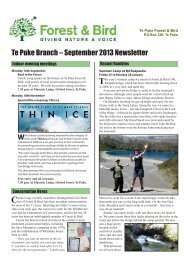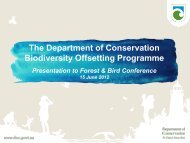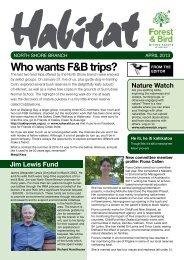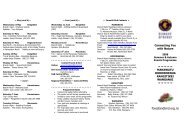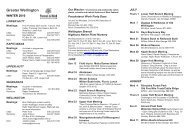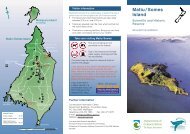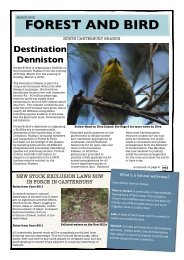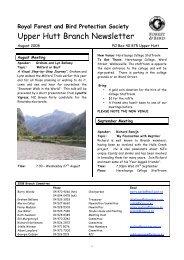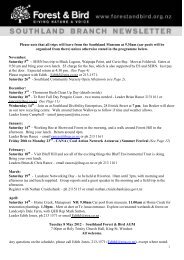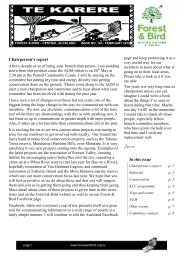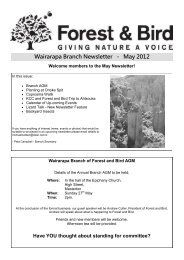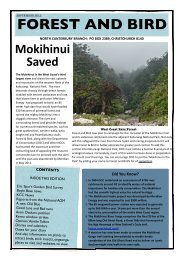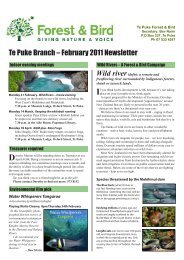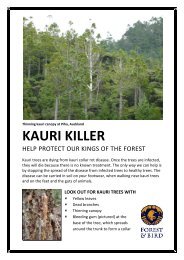methodology - Forest and Bird
methodology - Forest and Bird
methodology - Forest and Bird
Create successful ePaper yourself
Turn your PDF publications into a flip-book with our unique Google optimized e-Paper software.
E – least resilient to<br />
fishing<br />
5.4 Management <strong>and</strong> research<br />
aggregate (eg, when spawning), or form schools, long-lived, limited<br />
habitat of distribution, highly variable recruitment, or very specialised<br />
settlement requirements eg, school shark or rig,<br />
Unlikely to sustain exploitation beyond a very low level. Late onset of<br />
sexual maturity, few young, <strong>and</strong>/or rare, deepwater species, limited<br />
habitat/range, e.g., orange roughy or oreos.<br />
Fisheries managers rely on accurate research-based stock assessments to develop management<br />
regulations, including catch limits, to manage fishstocks well. Regulations include input controls such as<br />
seasonal closures, size limits <strong>and</strong> gear restrictions (trawl mesh size, length of gill nets) <strong>and</strong> output controls<br />
such as total allowable catches.<br />
The New Zeal<strong>and</strong> Ministry of Fisheries runs an annual fisheries stock assessment process. For some<br />
species, where stock assessment models are used, forward projections are undertaken to assess how the<br />
stock might respond to future catch levels (Annala et al.,., 2003; Sulliva, 2003; Sulliva, 2005; Sullivan et al.,.,<br />
2005; Ministry of Fisheries 2009, 2010, <strong>and</strong> 2011). Examples include hoki, orange roughy <strong>and</strong> oreo stocks.<br />
Determination of stock status <strong>and</strong> sustainable yield relies principally on obtaining accurate information<br />
from individual fishers over many years. This requires assumptions about the accuracy of the reporting of<br />
catches, extent of the fishing effort, <strong>and</strong> the location of fisheries. Poaching, illegal catches, inaccurate <strong>and</strong><br />
false reporting, <strong>and</strong> discarding complicate any assessment 13 . The wrong species may be reported or the<br />
reporting code may result in several species being reported together, for example, flatfish.<br />
Fisheries scientists therefore look for fisheries independent sources of information. These include r<strong>and</strong>om<br />
trawl surveys, acoustic surveys <strong>and</strong> tagging surveys. In addition, the presence of independent scientific<br />
observers on board vessels ensures additional biological information is collected <strong>and</strong> provides a baseline<br />
check against the accuracy of commercial fishers’ reporting, including information on bycatch (both fish <strong>and</strong><br />
non-fish).<br />
In New Zeal<strong>and</strong> independent scientific observer coverage is almost non-existent in inshore fisheries (less<br />
than one percent – 0.3 percent in 2007-08 – Abraham et al.,., 2010) <strong>and</strong> is usually low, with observer bias<br />
problems, in middle depth <strong>and</strong> deepwater fisheries (for example, oreos, orange roughy or hoki). Moves are<br />
being made to increase coverage in middle depth <strong>and</strong> deepwater fisheries.<br />
Most fisheries are managed based on commercial fishing returns such as catch effort returns, such as catch<br />
per trawl, longline set or pot-lift, so fisheries independent research is non-existent. The commercial return<br />
from many fisheries only provides effort information within large statistical areas <strong>and</strong> the actual position of<br />
the fishing effort (trawl, pot-lift or longline set) is not reported, for example, on catch l<strong>and</strong>ing returns in the<br />
many inshore fisheries 14 .<br />
Sustainable yields are usually calculated solely based on catch effort reports. This information provides<br />
little certainty on the long-term ecological sustainability of any fishery. A critical flaw is that in order to<br />
estimate yields in fisheries models a fish stock has been historically required to be “over-fished” <strong>and</strong> the<br />
population reduced to low levels to provide contrast in the data used in any stock assessment. This is not<br />
consistent with a precautionary approach to ecologically sustainable fisheries.<br />
Setting the total allowable catch (TAC) for a specific stock is divided up into total allowable commercial<br />
catch (TACC), recreational <strong>and</strong> customary catch, <strong>and</strong> all other fishing related mortality (such as illegal catch,<br />
13 Examples of mis-reporting include hake 7 as hake 4, under-reporting of hake (700-1000t/yr) <strong>and</strong> ling (250-400t/yr), silver warehou bycatch in the<br />
west coast hoki fishery, <strong>and</strong> estimated annual illegal catches of paua (400 tonnes) <strong>and</strong> rock lobster (230 tonnes) (Annala et al., 2003, Dunn 2003,<br />
Sullivan et al., 2005).<br />
14 Catch l<strong>and</strong>ing returns (CLR) only reports within large statistical areas <strong>and</strong> individual effort (eg trawls) are not reported separately. The alternative<br />
total catch effort processor return (TCEPR) is filled out by the larger trawlers. The current reporting system needs to be modified to ensure each<br />
individual unit of effort is reported separately.<br />
<strong>Forest</strong> & <strong>Bird</strong> Best Fish Guide 2012 – 2013: Criteria for Ecological Rankings 19


